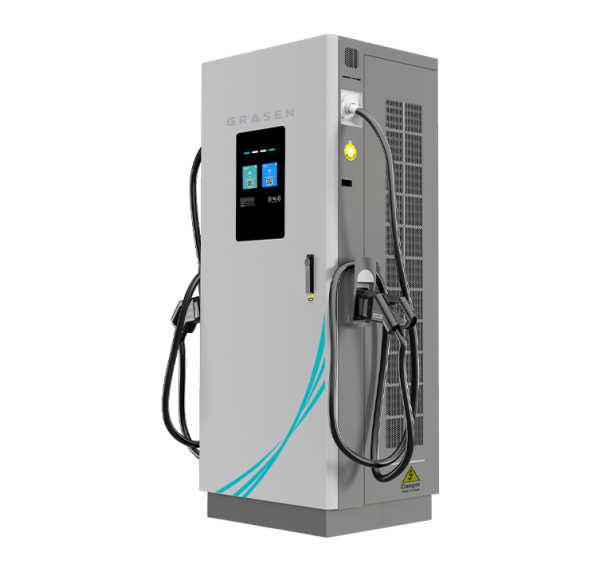The rise of electric vehicles (EVs) is driving a transformation in the automotive and energy industries. With a growing number of people making the switch to EVs, the demand for fast and efficient charging infrastructure is more pressing than ever. Enter the DC Fast Charger—a game-changing technology that has the potential to revolutionize the way we think about electric vehicle charging.
What is a DC Fast Charger?
DC fast chargers, also known as DCFCs (Direct Current Fast Chargers), are high-powered chargers designed to charge electric vehicles at a much faster rate than traditional chargers. Unlike standard AC (alternating current) chargers, which rely on the vehicle’s onboard charger to convert AC to DC, DC fast chargers deliver direct current (DC) power straight to the EV’s battery, bypassing the need for the conversion process. This means that DC fast chargers can provide significantly faster charging times, reducing the amount of time drivers need to spend at charging stations.
Key Features of DC Fast Chargers
- High Power Output: DC fast chargers deliver much higher power levels than regular chargers. While Level 1 and Level 2 AC chargers typically offer power in the range of 1.4 to 19.2 kW, DC fast chargers can provide power anywhere from 50 kW to 350 kW, depending on the model and location.
- Charging Speed: The most notable advantage of DC fast chargers is their speed. While an AC charger can take several hours to fully charge an EV, a DC fast charger can charge a vehicle up to 80% in as little as 30 minutes, depending on the vehicle’s battery size and charger power.
- Convenience: Fast charging significantly reduces the downtime for EVs, making long-distance travel and daily use much more convenient. DC fast chargers are often located along highways, at public charging stations, and in other high-traffic areas, allowing drivers to quickly charge their vehicles on the go.
- Compatibility with Various EVs: DC fast chargers use different types of connectors depending on the region and the vehicle model. The most common types are the CHAdeMO, CCS (Combined Charging System), and Tesla Supercharger connectors, each tailored for specific EV brands and regions.
How DC Fast Chargers Work
DC fast chargers work by delivering high-voltage direct current electricity directly into an EV’s battery. Here’s a step-by-step breakdown of the charging process:
- Connection: The driver connects their vehicle to the DC fast charger via a compatible charging cable.
- Communication: The vehicle and the charger communicate to determine the maximum charging power the vehicle can safely accept, taking into account the vehicle’s battery size, state of charge, and other factors.
- Charging: Once communication is established, the charger begins supplying high-power DC electricity directly to the vehicle’s battery. The charging rate is typically higher during the initial phase, gradually tapering off as the battery approaches 80% capacity to prevent overheating.
- Completion: Once the battery reaches the desired charge level, the charging process stops automatically. The driver can then disconnect the charger and continue their journey.
Benefits of DC Fast Charging
- Speed: As mentioned, the primary advantage of DC fast chargers is their ability to charge an EV in a fraction of the time it would take with a standard charger. This makes them ideal for long road trips, where drivers can stop for a quick charge and continue on their way with minimal delay.
- Accessibility: The growing number of DC fast charging stations around the world means EV drivers are less likely to face charging anxiety. Whether on a road trip or simply commuting, access to fast charging stations is becoming more widespread.
- Increased Adoption of EVs: As charging times decrease, more people may be encouraged to make the switch to electric vehicles, knowing that charging will no longer be a major inconvenience.
- Energy Efficiency: While charging is faster, the energy transfer from DC fast chargers is more efficient than slower chargers, resulting in less energy loss during the process.
Challenges of DC Fast Charging
Despite their many advantages, DC fast chargers face several challenges:
- Infrastructure Cost: Building and installing DC fast charging stations is significantly more expensive than installing Level 1 or Level 2 chargers. The high power output and the need for specialized equipment contribute to these high installation costs.
- Battery Health: Frequent use of DC fast charging can lead to faster wear and tear on the battery, potentially reducing the battery’s lifespan over time. However, most modern EVs are designed with sophisticated battery management systems to minimize the impact of fast charging.
- Grid Demand: DC fast chargers draw a large amount of power, which can place significant demand on local power grids. To mitigate this, energy companies are working to incorporate renewable energy sources and develop smarter grid technologies that can handle the increased demand.
- Limited Availability: While the number of DC fast chargers is growing, they are still not as ubiquitous as lower-powered chargers. Availability can vary by region, making it important for drivers to plan their routes accordingly.
The Future of DC Fast Charging
As the adoption of electric vehicles continues to rise, the demand for fast and efficient charging solutions will only increase. The technology behind DC fast chargers is continuously evolving, with advancements in charging speed, compatibility, and energy efficiency. In addition, we can expect to see more public and private investments in the expansion of DC fast charging infrastructure, making it easier than ever to charge EVs on the go.
